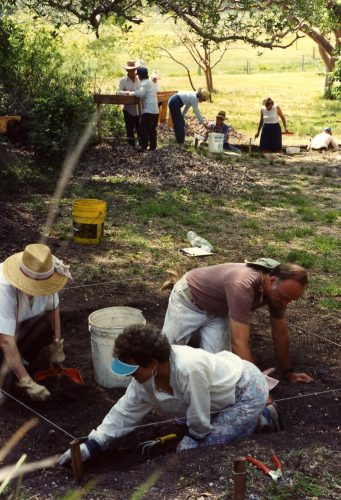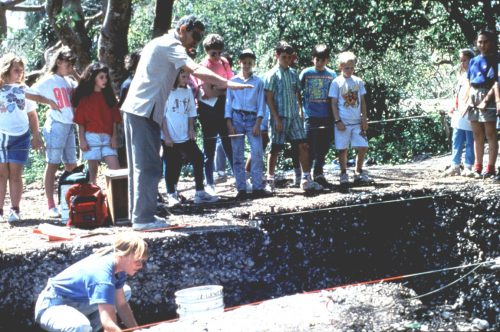In spite of its prominence, the Pineland Site Complex did not attract the attention of twentieth century archaeologists for over five decades after Frank Cushing’s published 1897 description.

In the early 1950s, limited archaeological reconnaissance work was accomplished by John Goggin and William Plowden. By the early 1970s, Donald and Patricia Randell had recognized the historical significance of the archaeological site, and they deserve much of the credit for protecting it.
Pineland was first listed in the National Register of Historic Places in 1972 when much of the property was under the ownership of the Randells. The Randells assembled approximately 80 acres of Pineland property and kept it in agricultural use. They kept a small herd of Santa Gertrudis cattle, tended and encouraged the citrus trees still growing on Citrus Ridge, and cultivated a vegetable garden. It was this pleasant, bucolic ambience that we first came to know during our work at Pineland in the 1980s and 1990s.
Previous to our work, the Randells had welcomed the interest of archaeologist George Luer, who first visited in 1980. Luer focused on Pineland’s historical resources and the Pine Island Canal, the latter in collaboration with Ryan Wheeler.
Our own history of archaeological work in southwest Florida dates to the 1980s. I first visited the Pineland site in 1983, met the Randells, and mapped the Josslyn Island archaeological site, then owned by them. Subsequent fieldwork included archaeological investigations at Buck Key, Galt Island, Cash Mound, Josslyn Island, Horr’s Island, Useppa Island, Mound Key, and other locations.
Funded in part by the National Science Foundation, we also undertook geological coring near archaeological sites to gather baseline environmental data, created archaeobotanical and zooarchaeological comparative collections, and collected marine specimens in order to study paleoclimate and paleoseasonality. The results of these studies have been reported in books, monographs, articles, videos, theses, and dissertations.
With the enthusiastic encouragement of the Randells, Karen Walker and I undertook preliminary testing of the Pineland Site Complex in 1988 and 1989, assisted by students and volunteers. In 1989, we began an ambitious archaeology/ education project in cooperation with the Lee County School System, Nature Recent History of the Pineland Community Part 4 in a series by Bill Marquardt Center of Lee County (now known as the Calusa Nature Center and Planetarium), and the Fort Myers Historical Museum (now known as the Southwest Florida Museum of History).

The project, called “The Year of the Indian,” was funded mainly by grants from the Florida Bureau of Historic Preservation and the National Endowment for the Humanities. The project featured three extensive excavation seasons (two of these – 1990 and 1992 – at Pineland), with over 25,000 hours of volunteer assistance; two local museum exhibits; a summer program for children; a multimedia slide show; a speaker series; hands-on classroom demonstrations and site visits for elementary school students; teacher training; curriculum development; and artifact replication research.
Our findings contributed to a permanent exhibit at the Florida Museum of Natural History in Gainesville, as well as two traveling exhibits, two web sites, and books for the lay public.
To be continued in the next issue: Part 5: Recent History of the Pineland Community
This article was taken from the Friends of the Randell Research Center Newsletter Vol 9, No. 2. June 2010.